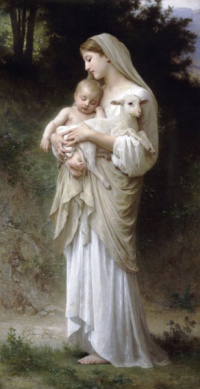Human bonding
From The Art and Popular Culture Encyclopedia

|
Related e |
|
Featured: |
Human bonding refers to the development of a close, interpersonal relationship between family members or friends. Bonding is a mutual, interactive process, and is not the same as simple liking.
The term is from the 12th century, Middle English word band or band, which refers to something that binds, ties, or restrains. In early usage, a bondman, bondwoman, or bondservant was a feudal serf that was obligated to serve his or her lord without pay. In modern usage, a bondsman is a person who provides bonds or surety for someone.
Bonding typically refers to the process of attachment that develops between romantic partners, close friends, or parents and children. This bond is characterized by emotions such as affection and trust. Any two people that spend time together may form a bond.
Male bonding refers to the establishment of relationships between men through shared activities that often exclude females. The term female bonding is less frequently used, but refers to the formation of close personal relationships between women.
Contents |
Etymology
The term is from the 12th century, Middle English word band or band, which refers to something that binds, ties, or restrains. In early usage, a bondman, bondwoman, or bondservant was a feudal serf that was obligated to work for his or her lord without pay (in modern usage, a bondsman is a person who provides bonds or surety for someone).
Early views
Plato
In the 4th century BC, the Greek philosopher Plato argued that love directs the bonds of human society. In his Symposium, Eryximachus, one of the narrators in the dialog, states that love goes far beyond simple attraction to human beauty. He states that it occurs throughout the animal and plant kingdoms, as well as throughout the universe. Love directs everything that occurs, in the realm of the gods as well as that of humans (186a-b).
Eyrximachus reasons that when various opposing elements such as wet and dry are "animated by the proper species of Love, they are in harmony with one another... But when the sort of Love that is crude and impulsive controls the seasons, he brings death and destruction" (188a). Because it is love that guides the relations between these sets of opposites throughout existence, in every case it is the higher form of love that brings harmony and cleaves toward the good, whereas the impulsive vulgar love creates disharmony.
Plato concludes that the highest form of love is the greatest. When love "is directed, in temperance and justice, towards the good, whether in heaven or on earth: happiness and good fortune, the bonds of human society, concord with the gods above- all these are among his gifts" (188d).
Ethics of Human Bondage or the Strength of the Emotions by Spinoza
In the 1660s, the Dutch philosopher Spinoza writes, in his Ethics of Human Bondage or the Strength of the Emotions, that the term “bondage” relates to the human infirmity in moderating and checking the emotions. That is, according to Spinoza ‘when a man is prey to his emotions, he is not his own master, but lies at the mercy of fortune.’
Goethe's Elective Affinities
In 1809 Johann Wolfgang von Goethe, in his classic novella Elective Affinities, speaks of the marriage tie and by analogy shows how strong marriage unions are similar in character to that by which the particles of quicksilver find a unity together though the process of chemical affinity. Goethe’s novella, in its time, was regarded as treatise on chemical origins of love. Humans in passionate relationships, according to Goethe, are analogous to chemical reactions.
See also
- Love and Love Sickness: The Science of Sex, Gender Difference and Pair-bonding
- Attachment theory
- Fission-fusion society
- Interpersonal relationship
- Interpersonal ties
- Monogamy
- Propinquity
- Relationship breakup
- Social contract

